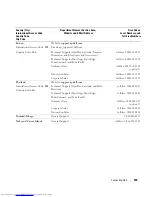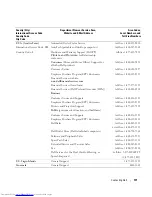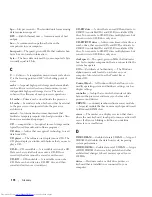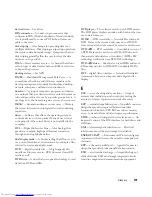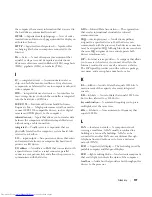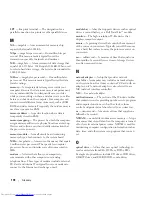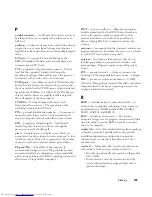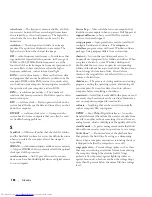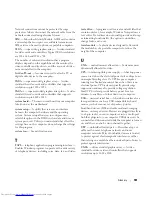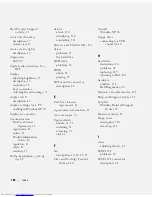
Glossary
181
Network connections cannot be protected by surge
protectors. Always disconnect the network cable from the
network connector during electrical storms.
SIM
— Subscriber Identity Module. A SIM card contains
a microchip that encrypts voice and data transmissions.
SIM cards can be used in phones or portable computers.
SVGA
— super-video graphics array — A video standard
for video cards and controllers. Typical SVGA resolutions
are 800 x 600 and 1024 x 768.
The number of colors and resolution that a program
displays depends on the capabilities of the monitor, the
video controller and its drivers, and the amount of video
memory installed in the computer.
S-video TV-out
— A connector used to attach a TV or
digital audio device to the computer.
SXGA
— super-extended graphics array — A video
standard for video cards and controllers that supports
resolutions up to 1280 x 1024.
SXGA+
— super-extended graphics array plus — A video
standard for video cards and controllers that supports
resolutions up to 1400 x 1050.
system board
— The main circuit board in your computer.
Also known as the
motherboard
.
system setup
— A utility that serves as an interface
between the computer hardware and the operating
system. System setup allows you to configure user-
selectable options in the BIOS, such as date and time or
system password. Unless you understand what effect the
settings have on the computer, do not change the settings
for this program.
system tray
— See
notification area
.
T
TAPI
— telephony application programming interface —
Enables Windows programs to operate with a wide variety
of telephony devices, including voice, data, fax, and video.
text editor
— A program used to create and edit files that
contain only text; for example, Windows Notepad uses a
text editor. Text editors do not usually provide word wrap
or formatting functionality (the option to underline,
change fonts, and so on).
travel module
— A plastic device designed to fit inside
the module bay of a portable computer to reduce the
weight of the computer.
U
UMA
— unified memory allocation — System memory
dynamically allocated to video.
UPS
— uninterruptible power supply — A backup power
source used when the electrical power fails or drops to an
unacceptable voltage level. A UPS keeps a computer
running for a limited amount of time when there is no
electrical power. UPS systems typically provide surge
suppression and may also provide voltage regulation.
Small UPS systems provide battery power for a few
minutes to enable you to shut down your computer.
USB
— universal serial bus — A hardware interface for a
low-speed device such as a USB-compatible keyboard,
mouse, joystick, scanner, set of speakers, printer,
broadband devices (DSL and cable modems), imaging
devices, or storage devices. Devices are plugged directly in
to a 4-pin socket on your computer or in to a multi-port
hub that plugs in to your computer. USB devices can be
connected and disconnected while the computer is turned
on, and they can also be daisy-chained together.
UTP
— unshielded twisted pair — Describes a type of
cable used in most telephone networks and some
computer networks. Pairs of unshielded wires are twisted
to protect against electromagnetic interference, rather
than relying on a metal sheath around each pair of wires to
protect against interference.
UXGA
— ultra extended graphics array — A video
standard for video cards and controllers that supports
resolutions up to 1600 x 1200.
Содержание INSPIRON PP05XB
Страница 1: ...w w w d e l l c o m s u p p o r t d e l l c o m Dell XPS M1710 Owner s Manual Model PP05XB ...
Страница 28: ...28 A Tour of Your Computer ...
Страница 36: ...36 Setting Up Your Computer ...
Страница 50: ...50 Dell QuickSet Features ...
Страница 77: ...Using Cards 77 1 smart card slot 2 smart card 3 ExpressCard slot 1 2 3 ...
Страница 78: ...78 Using Cards ...
Страница 116: ...116 Troubleshooting ...
Страница 144: ...144 Specifications ...
Страница 172: ...172 Contacting Dell ...
Страница 184: ...184 Glossary ...
Страница 190: ...90 Index 190 Index ...



